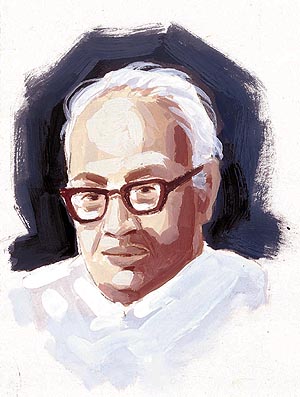WHEN Einstein announced his Special Theory of Relativity, Satyendra Nath Bose was only 11 years old. It was said at that time that only three persons in the entire world really understood the new theory, and yet, about a decade-and-a -half later, this little boy along with his childhood mate Meghnad Saha, would grow up to translate Einstein's revolutionary ideas. They wouldn't have known then that theirs was the first translation of Einstein's paper into English — the very first one in the world. But even in his wildest dreams, Satyendra Nath Bose might not have imagined that one day his name would permanently be linked with Einstein.
 In the early 1900s Max Planck's quantum theory was hot property. Planck proposed that energy is released in the form of quanta, that is in packets rather than in a continuous manner. He introduced his formula E= hv. Bose was not really comfortable with this theory, so he made his own investigations, and in 1924 came out with his paper: Planck's Law and Light Quantum Hypothesis.
In the early 1900s Max Planck's quantum theory was hot property. Planck proposed that energy is released in the form of quanta, that is in packets rather than in a continuous manner. He introduced his formula E= hv. Bose was not really comfortable with this theory, so he made his own investigations, and in 1924 came out with his paper: Planck's Law and Light Quantum Hypothesis.
Since he was a youngster at the time, Bose decided to send a copy of his paper to Einstein. "I have ventured to send you," he wrote, "the accompanying article for your perusal and opinion. I am anxious to know what you think of it. You will see that I have tried to deduce the coefficient in Planck's laws independent of the classical electrodynamics only assuming that the ultimate elementary regions in the Phase space had the content h3."
Bose's short paper considered radiation as a form of gas consisting of photons. Einstein was so impressed by the paper that he himself translated it into German, and sent it to the editor of Zeitschrift fur Physik. He had seen immediately that it was possible to extend Bose's statistical methods to ordinary atoms. This method came to be known as Bose-Einstein statistics. Einstein developed this theme in a two-part paper for the Prussian Academy. "In my opinion," Einstein wrote, "Bose's derivation of Planck's formula signifies an important development. The method considered here yields also the quantum theory of ideal gases which I shall discuss elsewhere."
It was not long before Bose produced another paper: Thermal Equilibrium in Radiation Field in Presence of Matter. He once again sent it to Einstein for comment, and the latter read it and had it published in Zeitschrift. But this time Einstein said that he did not fully agree with Bose.
Later Bose went to Europe to meet Einstein and other great scientists. For a while he worked with Madame Curie. While in Paris, he got interested in X-ray crystallography after meeting the famous de Broglie brothers. Impressed with the young scientist, the brothers invited him to be their guest at their estate. After a year in France, he would spend the next year with Einstein in Berlin.
Before 1908, just a few colleges had science in their curriculum. In 1916, Sir Asutosh Mookerjee decided to convert Calcutta University into a centre for teaching science. He immediately appointed Satyendra Nath Bose and Meghnad Saha to the Applied Mathematics Department. Both of them could not get along with Ghosh Professor of Applied Mathematics, Dr Ganesh Prasad. With Sir Asutosh's permission both of them got transferred to the Department of Physics.
It was a time when the Planck's Quantum Theory, Einstein's Theory of Relativity, and Bohr's theory of hydrogen spectrum had taken the world of physics by a storm. Intrigued by these developments, Bose taught himself physics, because the university did not even have good books and science journals.
Bose's first paper The Influence of the Finite Volume of Molecules on the Equation of State was jointly written with Meghnad Saha. It was published in Philosophical Magazine in 1918. His next two papers were published in Bulletin of the Calcutta Mathematical Society in 1919 and 1920. They were on The Stress Equations of Equilibrium and Horpol Hode. Both were based purely on mathematical problems.
No comments:
Post a Comment